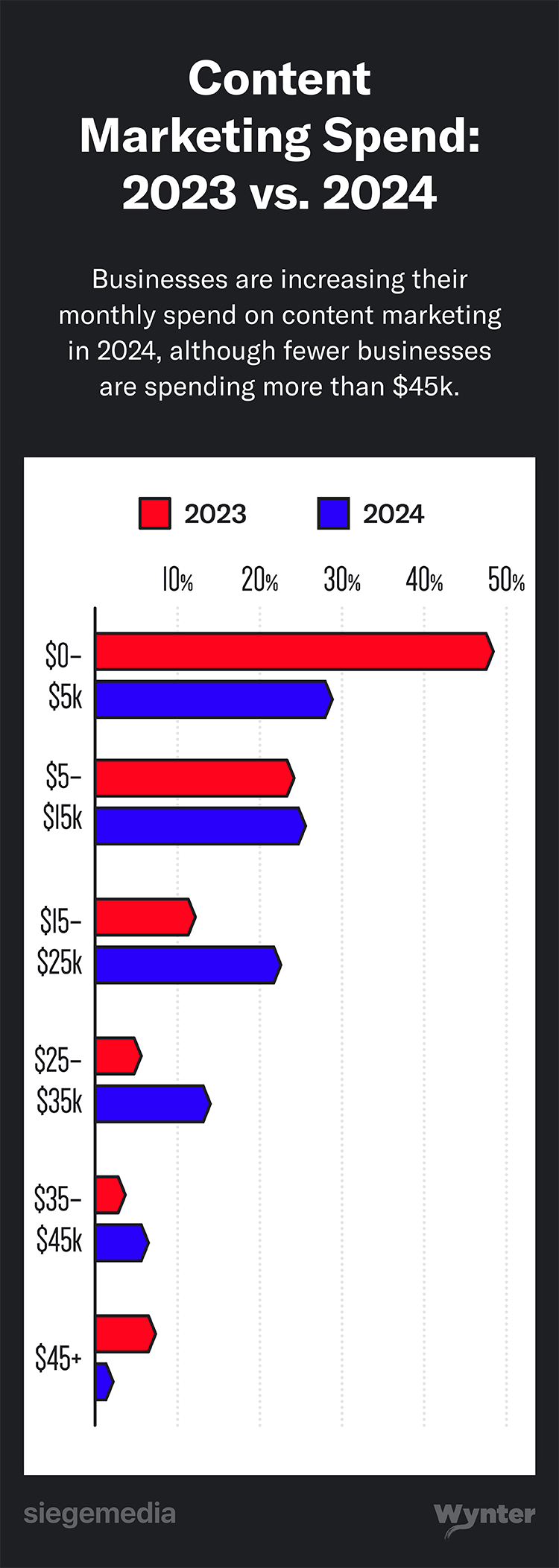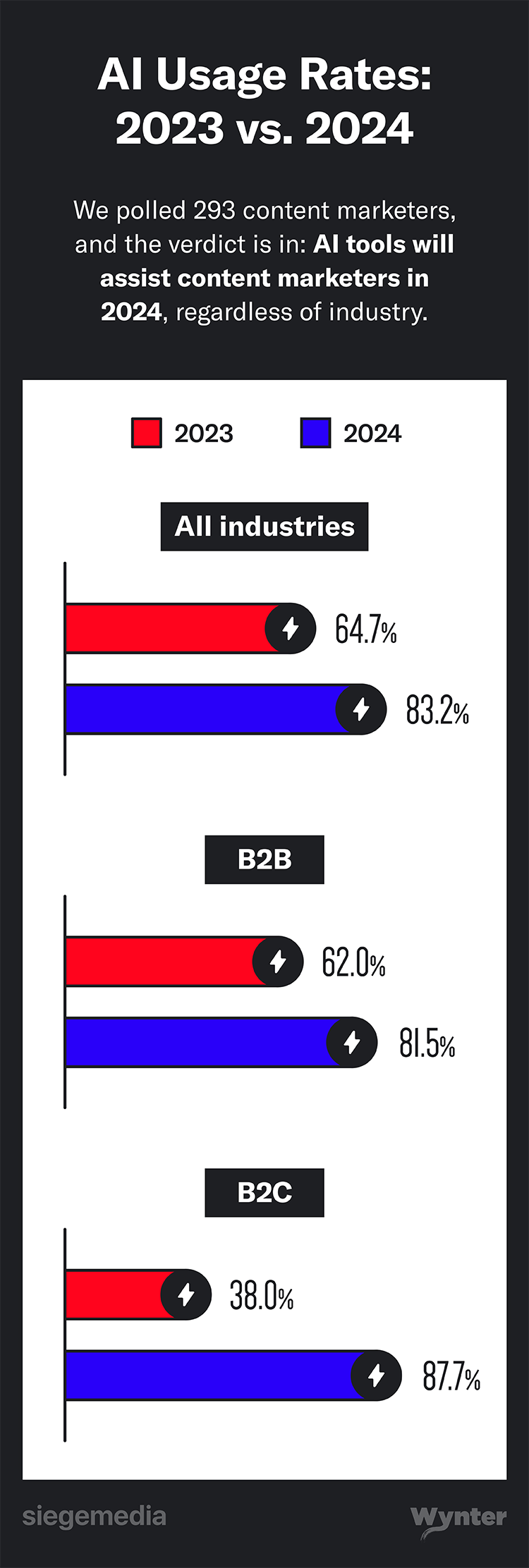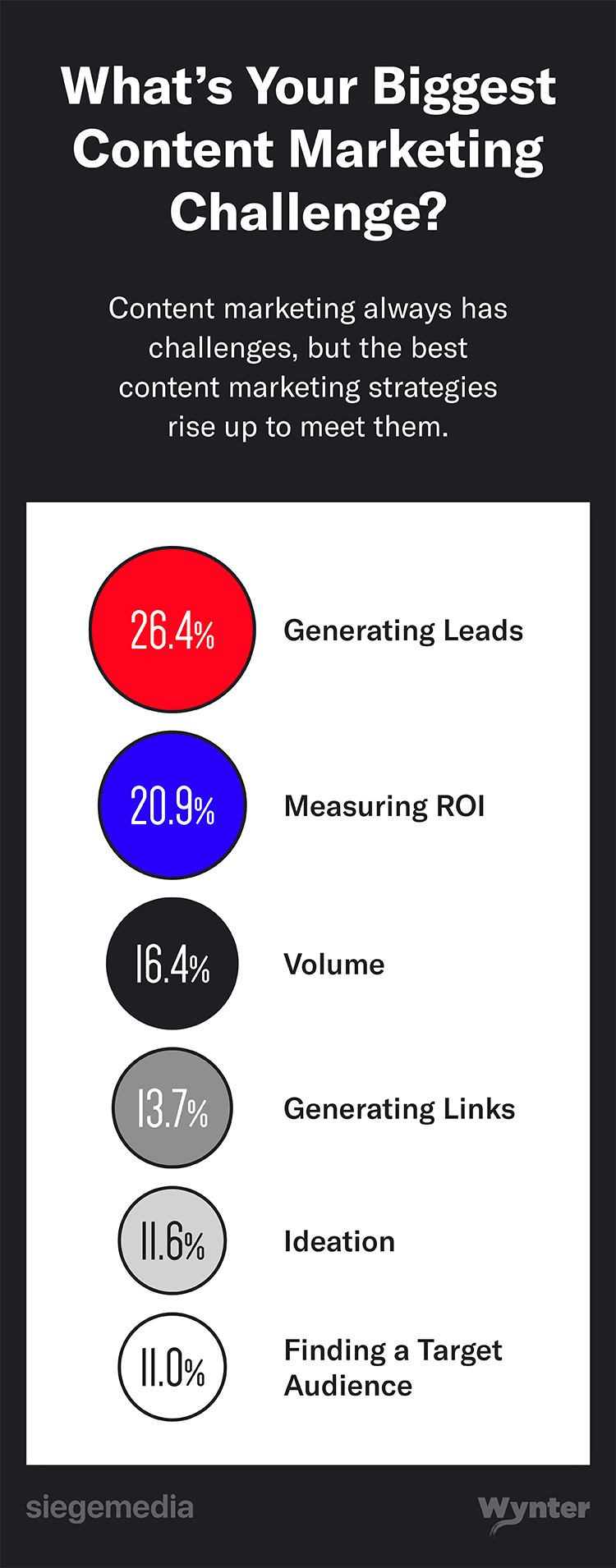Like all things digital, the landscape of digital marketing shifts daily. From algorithm updates to new platforms and tools, digital marketers have a lot to consider when designing their annual strategies. Fortunately, the one thing everyone can agree on is the importance of content marketing.
We teamed up with Wynter, a B2B market insights company, to create a 2024 content marketing trends report. We asked 293 content marketers about their plans for content strategy, AI, and budget in 2024 to understand where the future of content marketing is heading.
Key Takeaways:
- AI usage is up, from 64.7% in 2023 to 83.2% in 2024. B2C saw the biggest increase in usage, from 38% to 87%.
- Humans still perform better — 20.9% of users who weren’t using AI reported being very successful, while only 12% that used AI did.
- Link building focus is on the rise, with only 5.5% of respondents saying they will not prioritize it compared to 14.7% in 2023.
- Those who favor organic link building perform better on average, where 50.6% report being mildly successful or better, while only 35.3% of those who execute manual link building report being mildly successful or better.
- Interactive content interest is increasing, with 62.3% reporting investment in the area vs only 36.1% in 2023.
They say knowledge is power, so we’re sharing our findings and key takeaways to help you improve your content strategy.
- Content Marketing Isn’t Dead
- AI Tools: Pieces of the Content Puzzle
- If Link Building Isn’t Part of Your Strategy, It Should Be
- Customers Want Engaging Content
- Generating Leads Is a Challenge
- Energize Your 2024 Content Marketing Strategy With Siege Media
Content Marketing Isn’t Dead
For the past few years, between an uncertain economy and the rise of AI, content marketers have been subjected to clickbait headlines claiming the content marketing sky is falling. Fortunately, that isn’t the case at all.
In fact, we’ve learned businesses are growing their commitment to content marketing.

More than half of businesses (54.5%) plan to spend more on content marketing in 2024 than in 2023. This continues the trend we saw in our 2023 content marketing trends report, suggesting that it might be time to bury those doom-and-gloom predictions for good.
Overall, businesses are spending more on their content per month in 2024 than in 2023, although fewer businesses spend more than $45K monthly. Nearly half (47.6%) plan to spend $5K to $25K on content marketing in 2024.
Businesses are also spending more per piece on average in 2024. In 2023, 44.4% of businesses spent just $0-$500 per piece of content, which will fall to 20.9% in 2024. Over half (53.1%) of survey respondents plan to spend between $550 to $2,000 per piece of content this year.
Increased spending per post strongly correlates with success level — a business that spends more than $4,000 or more per post is about 2.6 times as likely to report its strategy as “very successful” than a business that spends $0-$500.
In fact, about 20% of businesses spending $0-$500 reported their strategy underperformed slightly, while 0% of businesses spending at least $4,000 did. So if you want the most successful strategy, investing more money (intelligently) is key.

So why the spending increase despite all the doom and gloom economy talk? Because it works.
A typical person spends nearly seven hours a day on the internet, and that’s in addition to whatever time they spend online for work. So, it makes financial sense to focus your marketing efforts on where your target audience is: scrolling online.
Data supports this — content marketing produces three times as many leads as traditional marketing with a price tag that’s 62% less.
But don’t take this to mean you should just throw more money at content marketing in 2024. The key is to invest in high-quality content that gets the job done so you can get the best bang for your buck. Whether creating videos for social media, ebooks to walk your customers through a challenge, or publishing how-to blog posts, they must be helpful.
Writing blog content that converts is our bread and butter, and we know great blog posts should:
- Target a specific audience.
- Have an SEO-optimized structure.
- Be skimmable.
- Have eye-catching visuals.
- Include a clear CTA.
If you’re paying for content that doesn’t include those elements, you won’t see results — no matter how much of your budget you devote to it.
AI Tools: Pieces of the Content Puzzle
We don’t know about you, but it seems like we constantly hear that AI is coming for our jobs. After all, robots never take a sick day or require a costly benefits package.
However, our data shows that the increased use of AI tools coincides with increased content marketing budgets, suggesting that’s not why businesses are turning to it.
In 2023, 64.7% of content marketers planned to use AI tools, skyrocketing to 83.2% in 2024. B2C businesses are making the most significant jump into AI tools, with 87.1% planning to implement AI tools in 2024 (up nearly 50% from 2023), although that may be because they’ve used it less than B2B businesses in previous years.

While businesses are embracing AI tools more than ever, they aren’t relying on them to design content end-to-end:
- Most respondents (71%) reported using AI tools to help with content ideation, such as brainstorming a list of keywords to target as part of their content marketing strategy.
- Nearly 70% of respondents reported using AI tools to assist with brainstorming content development, including creating outlines.
- More than a third (40%) of respondents reported using AI tools to help them create overall strategies, such as generating personas.

Fortunately for living, breathing content marketers, robots aren’t up to replacing us just yet. While 43.8% of those using AI reported above-average success, so did 48.6% of those who aren’t using AI. This suggests that while AI can be a powerful tool to speed up the process, human marketers still have an edge in creating successful content.

While marketers are using AI tools to generate content and design elements (47% and 28%, respectively), that’s where content marketers should be most cautious in using AI.
Robo-writing tools may be able to pump out more content for a lower cost, but AI can’t feel emotion and be spontaneous like a human can. It spits out language based on the patterns it sees in the data it consumes, so it can’t accurately embody the brand style that sets you apart from your competitors.
As a result, AI-generated writing is often devoid of the creativity that makes content shine (and pulls in leads). Personal narratives and touches drive users—they’re more likely to convert after reading a real-world personal narrative of how a product helped someone like them, and AI writing tools can’t do that.
Plus, as great as AI is at some topics, it isn’t an industry expert and can miss nuances or be flat-out wrong.

Instead, focus AI content marketing on streamlining the content creation process (and always under the supervision of a human to make improvements) by:
- Identifying trending or popular topics you should include in your strategy
- Comparing your content to a competitor’s to find content gaps
- Determining what sections to include in an outline
- Catching grammar and spelling mistakes
In short, businesses should only use AI to support their content marketing team, not replace them.
If Link Building Isn’t Part of Your Strategy, It Should Be
The importance of link building continues to be an ongoing debate in the content marketing industry. Is it better to do it manually or organically? How much value does Google tie to links?
Regardless of where you stand, link building is more of a priority in 2024 than in 2023, with only 5.5% of respondents saying they will not prioritize link building (while 14.7% said the same in 2023).
Prioritizing link building as part of your strategy correlates with higher levels of success.
Of the 27 businesses who responded link building is “very prioritized,” 57.2% reported their overall content marketing strategy as mildly or very successful. In contrast, only 11.2% of the 17 respondents who barely prioritized link building as part of their strategy considered their overall marketing strategy mildly or very successful.

More than half (56.4%) of respondents with a link building strategy report relying on organic link generation rather than manual outreach to fuel their link building efforts.
In most established industries, we’ve found that this strategy often results in links that outpace those generated by manual outreach—so much so that in 2022, we stopped doing most of our manual outreach. However, organic link building is only successful when you have the following in place:
- High-quality content that attracts links (e.g., surveys, data studies, templates, etc.)
- An internal linking strategy that prioritizes organic link generators
- A link to the content hub in the top navigation
- A curated content library that links to 15+ posts on the content hub
Without those four things in place, you’ll struggle to get links organically at your desired rate.
In today’s competitive landscape, “good enough” content is the same as “bad content.” Siege Media delivers great content so you can stand out. Learn moore about our content marketing services.
Customers Want Engaging Content
In 2023, only 36.1% of respondents reported creating interactives like calculators, quizzes, or tools.
In 2024, that number nearly doubled, with 62.3% of respondents creating interactives as part of their content marketing strategy.

Interactives are the heavyweight champs of link building, which is why 68.4% of businesses who prioritize link building create interactives as part of their strategy, compared to 56.3% who don’t prioritize link building. Not only do they attract links, but they are also high-converting.
Once you engage the user, they’re more likely to remember you when they need to make a purchase. You helped them out of a jam (with a debt payoff calculator, for instance) or provided them with something memorable (a flashy quiz to help them pick a paint color based on their personality).
Not everyone can put together a powerful interactive that is worth the time and effort, which means if you have a great one, you’ll find yourself standing head and shoulders above your competition.

Generating Leads Is a Challenge
Content marketing isn’t without its challenges. This year, content marketers reported generating leads as their greatest challenge, followed closely by measuring ROI.
In comparison, the two biggest challenges in 2023 were volume (27.8%) and generating leads (22.6%).

The secret to generating leads starts with identifying the right content for your target audience, which is why keyword research is so important.
At Siege, we start every content marketing strategy with a Keyword Opposition to Benefit (KOB) Analysis, which allows us to analyze hundreds of keywords and prioritize the ones that will generate traffic, links, and leads.
Energize Your 2024 Content Marketing Strategy With Siege Media
More than 90% of our respondents outsource at least some of their content marketing strategy. However, that doesn’t correlate with higher success levels, probably because it depends on the quality of your outsourcing partner. It doesn’t matter how much you pay them—if they don’t deliver results, they aren’t worth it.
At Siege Media, we can help you put these trends into motion, elevating your content marketing strategy through data-driven insight and creating unparalleled content focused on your customer. The results speak for themselves. Reach out today to learn how we can help you reach your content marketing goals in 2024.
Methodology
We partnered with Wynter to send the survey to 100 SEO professionals, content marketing managers, content leads, directors of content, and other content marketing experts in their database.
We also shared the survey with our newsletter subscribers and social media followers to get an additional 193 responses from our audience to target content marketers and thought leaders in the industry, for a total of 293 survey respondents across B2B and B2C businesses in the SaaS, health and wellness, online media/publishing, e-commerce, and finance industries.




